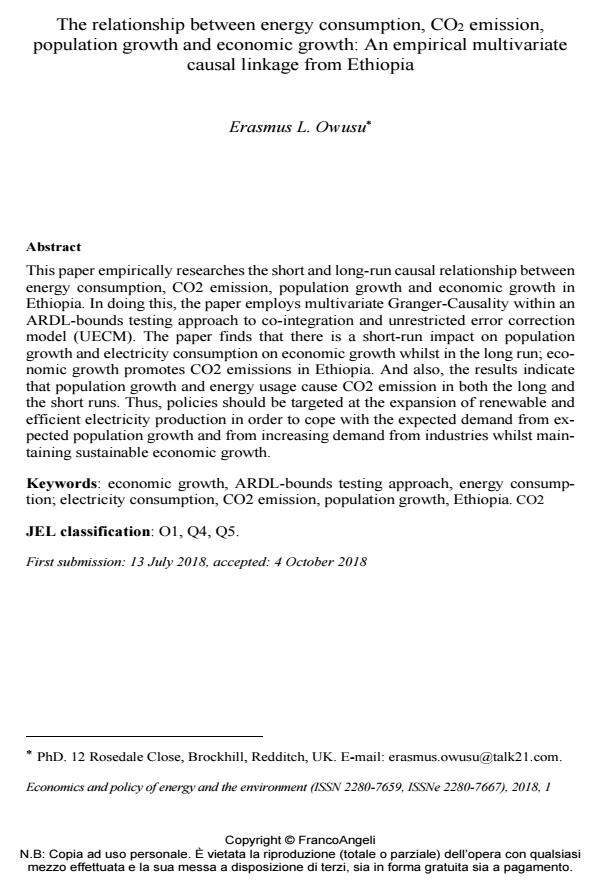The relationship between energy consumption, CO2 emission, population growth and economic growth: An empirical multivariate causal linkage from Ethiopia
Titolo Rivista ECONOMICS AND POLICY OF ENERGY AND THE ENVIRONMENT
Autori/Curatori Erasmus L. Owusu
Anno di pubblicazione 2019 Fascicolo 2018/1
Lingua Italiano Numero pagine 15 P. 225-239 Dimensione file 221 KB
DOI 10.3280/EFE2018-001010
Il DOI è il codice a barre della proprietà intellettuale: per saperne di più
clicca qui
Qui sotto puoi vedere in anteprima la prima pagina di questo articolo.
Se questo articolo ti interessa, lo puoi acquistare (e scaricare in formato pdf) seguendo le facili indicazioni per acquistare il download credit. Acquista Download Credits per scaricare questo Articolo in formato PDF

FrancoAngeli è membro della Publishers International Linking Association, Inc (PILA)associazione indipendente e non profit per facilitare (attraverso i servizi tecnologici implementati da CrossRef.org) l’accesso degli studiosi ai contenuti digitali nelle pubblicazioni professionali e scientifiche
This paper empirically researches the short and long-run causal relationship be-tween energy consumption, CO2 emission, population growth and economic growth in Ethiopia. In doing this, the paper employs multivariate Granger-Causality within an ARDL-bounds testing approach to co-integration and unre-stricted error correction model (UECM). The paper finds that there is a short-run impact on population growth and electricity consumption on economic growth whilst in the long run; economic growth promotes CO2 emissions in Ethiopia. And also, the results indicate that population growth and energy usage cause CO2 emis-sion in both the long and the short runs. Thus, policies should be targeted at the expansion of renewable and efficient electricity production in order to cope with the expected demand from expected population growth and from increasing de-mand from industries whilst maintaining sustainable economic growth.
Parole chiave:Economic growth, ARDL-bounds testing approach, energy consump-tion; electricity consumption, CO2 emission, population growth, Ethiopia. CO2
Jel codes:O1, Q4, Q5.
- IV INTERNATIONAL SCIENTIFIC AND TECHNICAL CONFERENCE “ACTUAL ISSUES OF POWER SUPPLY SYSTEMS”: ICAIPSS2024 Jiyengu’l Erejepova, Umidbek Abdalov, Sevinchbek Egamov, Sukhrob Davlatov, Shakhinya Igamova, pp.030023 (DOI:10.1063/5.0306549)
Erasmus L. Owusu, The relationship between energy consumption, CO2 emission, population growth and economic growth: An empirical multivariate causal linkage from Ethiopia in "ECONOMICS AND POLICY OF ENERGY AND THE ENVIRONMENT" 1/2018, pp 225-239, DOI: 10.3280/EFE2018-001010